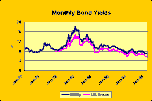| Results |
|---|
| Shortcomings |
| Results |
|---|
| Shortcomings |
The risk premium method is based on the premise that the premium that an investor expects to earn for an equity investment is fairly constant over time. Therefore, if that premium can be calculated using historical data, it can be added to some measure of current or projected debt cost to provide an indication of expected cost of equity. In addition to the simple risk premium model, there is a somewhat more sophisticated variation called the Capital Asset Pricing Model (CAPM).
 |
| Historical Cost of Debt |
The simple risk premium calculates an equity premium for each quarter or each year over the utility cost of debt for a 5 to 10 year historical period, using the DCF method for equity cost each period. Then the average premium is added to the current or projected interest rate.
See schedule 2, page 4 of 8, of the attached 78 KB EXCEL file for a simple risk premium real life application from a Florida Power & Light rate case. One problem with this approach is that it is rather circular, in that the DCF calculation of cost of equity is used to calculate the premium, which in tern is used to calculate the cost of equity.
The capital asset pricing model calculates the cost of equity using modern portfolio theory, according to the following equation:
This yield should preferably be a forecasted rate, or at least a current rate. One source of long term interest rate forecasts is the Energy Information Administration Annual Energy Outlook (see Page 125 of the 1998 Outlook). As its name implies, it is only published once a year (in December). Another source for forecasted rates which comes out monthly, is the Blue Chip Interest Rate publication. However, you will find that more often than not, the consensus forecast is not much different than actual interest rates with a little time lag.
Beta can be obtained from various sources such as Bloomberg, Value Line or INVESTools. However, Beta can vary greatly depending on how it is calculated (e.g. over what time period)
The market risk premium is best obtained from a recent edition of Ibbotson Associates Yearbook, which unfortunately you'll probably have to pay for.
In the CAPM method, there is an implicit assumption that the investor expects to earn equity premiums consistent with long term historical realized returns.
